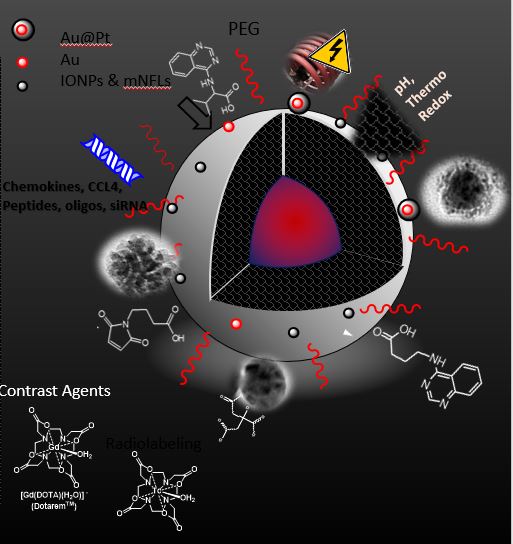Nanomaterials Synthesis Bio App
Nanostructured delivery and diagnostic systems that induce specific targeting properties by exploiting the local physicochemical tumor characteristics are being evaluated in the present activity. Cancer cells have specific physicochemical characteristics, which can be taken into consideration for the design of a broad spectrum of drug delivery systems (DDS). Some of those characteristics include the different temperature environment their susceptibility when temperature ranges between 40-43℃ where cell apoptosis is induced, the intra- and extra- cellular pH which varies from 6.0 to 6.8, for cancer cells, and 6.5 to 7.4 for normal cells respectively, (lysosomes acidic pH ranges 4-5). Additional significant factors are the overexpressed receptors on the tumor surface. Loading and release studies are carried out using the anthracycline drug Doxorubicin and their cytotoxicity is evaluated using the MTT assay in healthy and diseased cell lines. The highlight of our work is the in vitro and in vivo study which was performed in order to evaluate different nanostructures as for their biodistribution, pharmacokinetic and toxicity per se.

According to our concept different types of NPs are prepared:
- Core-shell composite nano-carrier with an inner cavity was formed by soap-free radical emulsion polymerization, based on a variety of monomers with specific sensitivities. The synthetic route contains two steps. In the first step, a non-toxic spherical core is synthesized and in the second step, the shell is formed by a combination of monomers. Each monomer exhibits a unique sensitivity such as pH, thermo and redox sensitivity. Taking advantage of this behavior, we synthesized a nano-container (NC) able to respond to external stimulus causing drug release in a controlled manner. A loading and release study of 3,4-diaminobenzoic acid derivative was also carried out and the cytotoxicity of the synthesized DDS was investigated using MTT assay. The hemolytic activity of the NCs was performed in erythrocytes and in whole blood cells evaluating its biocompatibility. The ability to maintain highest therapeutic efficacy remains an important goal for the development of DDSs.
- Air (NBs@air) and oxygen nanobubbles (NBs@O2) were evaluated in terms of size and colloidal behaviour as well as are evaluated on cell lines. NCTC, healthy human keratinocyte cells, and M6, human melanoma cells were used to assess the effect of the NBs on the migration ability of cells by the wound healing assay.
- Polymer nanospheres doped with semiconductor quantum dots (QDs). This hybrid nanomaterial is expected to find use in a variety of in vitro and in vivo biological applications.
- Magnetic nanoparticles modified with different reducing and coating agents in one step synthesis are synthesized and coated with PEG-co-PLA copolymer. The modified mNPs are evaluated by using the MTT assay in different cell lines, healthy and diseased.
Reference
Synthesis, characterization and evaluation of multi sensitive nanocarriers by using the layer by layer method, T. S. Koutsikou, M. G. Krokidis, N. Boukos, G.Mitrikas, E. Efthimiadou, Journal of Drug Delivery Science and Technology 53, 101142 (2019) DOI: 10.1016/j.jddst.2019.101142